PAEDIATRIC EXOSKELETON
ATLAS 2030
The ATLAS 2030 is a THKAFO type walking exoskeleton, which supports the child from the trunk to the feet. It does not require chest control and can be fitted with a head support system. The exoskeleton consists of 8 active joints that provide full mobility in all directions. .The dimensions of the device are easily adjustable to the child’s growth. It is easily fitted in 5 minutes. It is accompanied by an auxiliary frame that can be attached to the exoskeleton to ensure the patient’s safety and give the child the sensation of walking on their own, as well as making it easier for the therapist to interact with the patient face to face, without the need to stand behind the patient and hold them. The exoskeleton interprets the patient’s movement intention non-invasively and responds to this intention with each step. It can also work passively, generating a specific gait pattern for each patient. Includes extra batteries.

CLINICAL BENEFITS

Expansion and maintenance of joint range.

Improved muscle strength.

Maintenance, through prolonged use, of scoliosis and improvement of respiratory function.

Reduction of muscle contractures and regulation of muscle tone.

Prevention or delay of musculoskeletal complications of neuromuscular diseases.

Improved ability to perform activities of daily living. In addition to improved self-esteem and well-being.
PRODUCT INFORMATION

PAEDIATRIC EXOSKELETON
ATLAS 2030 is the world’s first pediatric floor exoskeleton specifically designed to assist walking for children with neurological and neuromuscular diseases.
It consists of 8 active joints and assists walking both forwards and backwards. It is adjustable to the measurements of each child and can be parameterised according to the characteristics and limitations of each patient. It can be used passively, generating a specific and personalised walking pattern, or actively, using and training the child’s own muscular strength. The supporting frame provides stability and support to the exoskeleton so that it is no longer necessary for the therapist to hold the device from behind while walking.
This allows the therapist to be free to position himself in front of the child and have his hands free to interact with the child while performing rehabilitative activities involving the rest of the body for global rehabilitation.
Finally, ATLAS 2030 allows full exploration of space by walking, which offers children great opportunities for participation and inclusion, as well as high motivation.
EXPERTS OPINIONS
OUR LITTLE HEROES
-
"The doctors were "hallucinating" about the result. He gained a lot of strength and even grew two centimetres just by standing up straighter. He felt better, he breathed better, his joints worked better, his dislocated hips started to settle.... If in two months we noticed all this, we wonder what it would be like to use the exoskeleton every day of our lives...". Ana, Álvaro's mother. Read more

-
"We have noticed improvements across the board. Since he has been using the exoskeleton, now he only wants to walk. There has been evolution at a motor level, but above all we have experienced his cognitive awakening". Mayte, Alex's mother. Read more

-
"The emotional and physical changes from wearing the exoskeleton are incredible, her smile says it all". Pamela Martinez, Samantha's mother. Read more

-
"It was, above all, a feeling of happiness, to see how he could stand, how he could walk. Her excited face, seeing that she could keep up with everyone, was marvellous. Arantxa, Sofia's mother. Read more

-
"He loves to see himself standing on his robot. He loves playing football. The exo has lifted his mood. The first day he said to me: 'mummy, I walked'. It's fascinating to see the huge expectations for improvement that exo brings. I'm hopeful that Fer will be able to walk with a cane or a walker. "He can already eat when you put his plate in front of him. The goal is for Fer to be able to be autonomous in his daily life". Mariana, Fernando's mother. Read more

-
"The exoskeleton is a very important change for her life, the simple fact of seeing her on her feet is incredible". Read more

-
"The experience of using the exoskeleton was unforgettable, especially for the child. To see himself standing up after never having done it on his own, to be able to walk and to be able to kick a ball was incredible for him, he was very excited". "They put him in a sitting position, and the moment he got up was indescribable. When they lifted him up and he saw that he could take those steps, the look of happiness and amazement on his face was incredible." Carmen, Tiago's mother. Read more

-
"We are thrilled, because we are convinced that for children who cannot walk like Iris, who most want to walk, this is the beginning of autonomy. This, from an emotional point of view, is undoubtedly a tremendous gain for children who are always dependent on others". Pedro, Iris's father. Read more

-
"Throwing a ball standing up, shooting at a target or playing with his sister, activities that for any parent may seem normal for us are a novelty. It has changed our lives, it has been a turning point not only in Jorge's life, but in the whole family's."- Eva, Jorge's mother. "It gives us hope that Jorge will be able to evolve, making more and more progress and feeling happier and more complete every day". José, Jorge's father. Read more.

-
"Just by trying it for two days, Juan improved his gait pattern a lot. The result was great. This can only be achieved with months of rehabilitation". Marta Peña, Juan's mother. Read more "The first time he used the exoskeleton it was very nice, Juan loved it and for us it is a light of hope because when they sit for a long time they have many digestive and respiratory problems, their muscles atrophy and the fact that this device makes them stand upright alleviates these problems. The exoskeleton not only increases their quality of life but also their life expectancy". Pablo, Juan's father. Read more

-
"The girl is adapting well and although she is not aware of it, we know how important this step is for her development". Beatriz, Alba's mother. Read more

-
"For us, research is a world, every minute that is gained, every minute that is advanced, is time that they gain". Israel, Victor's father. Read more

-
"Alejandro has been coming to the exoskeleton with a smile on his face from day one, super motivated and happy. Every day that goes by he is doing better, he takes more and more steps in intention. With less than 3 months of assistance we can already see that in his physiotherapy sessions he is starting to take more steps voluntarily and autonomously. There is still a long way to go, but he now takes 2 or 3 steps in a row more frequently or more easily than before, when he hardly took any steps on his own. These steps are with help or on a "cricket" but they are.... a small breakthrough. His alertness during the whole session is excellent and this is also reproduced at home in ball games as he plays there".

-
"To see Adolfo on his feet and walking is a dream, it has always been a dream and we are not going to lose sight of it. Now, thanks to the work of specialists, physiotherapists and researchers, it is a possible dream. Adolfo, the first time he used the exoskeleton, said: "Mum, I didn't know what walking was". And now he does". Vídeo of the Community of Madrid

-
"Noa's character has changed a lot. She likes to walk, to stand up and she is happy and content". David Sánchez, Noa's father. Read more

-
“For Minerva, the exoskeleton has been an accelerator. It has given her a huge boost and has been a very important step forward in her rehabilitation. It’s a turning point, and as her mother, I find it very emotional”. María Rolanda, Minerva’s mother
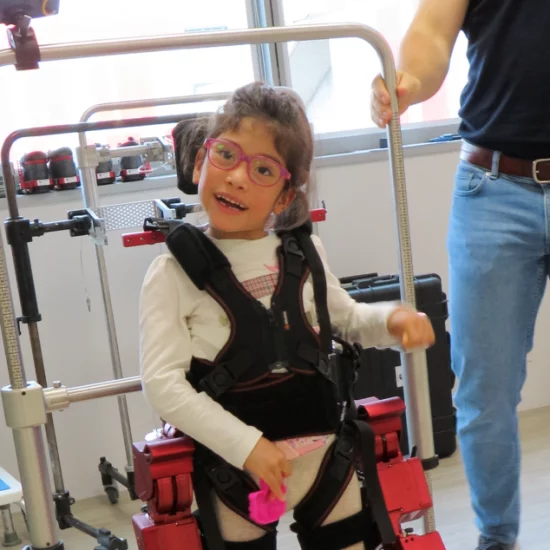
-
"Iria's face lights up when she sees the exoskeleton, when she sits down and when she stands up. I think she has made a lot of progress and I am very happy, and so is she". María, Iria's mother. Read more
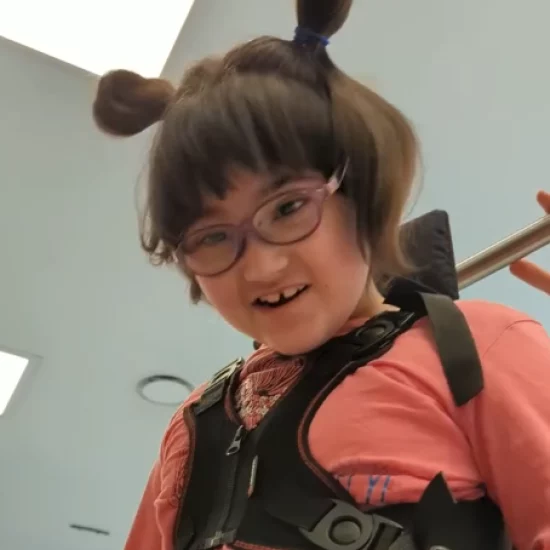
-
"With the exoskeleton, what I see on my son's face is happiness and, above all, how it has broadened his interests. When that happens, you can see that the child is evolving. He is making social discoveries, with more things around him. It has been that point of interaction, of play, the result of a cognitive change". Estela, Marcos's mother
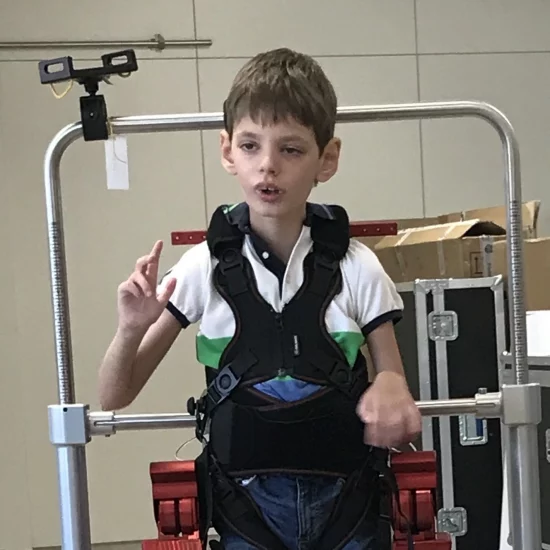
-
"We have seen how Ghalia has improved greatly in terms of mobility, strength and independence. The first time we saw her standing up was incredibly exciting. It gave me goosebumps and made me want to cry". Débora, Ghalia's mother. Read more
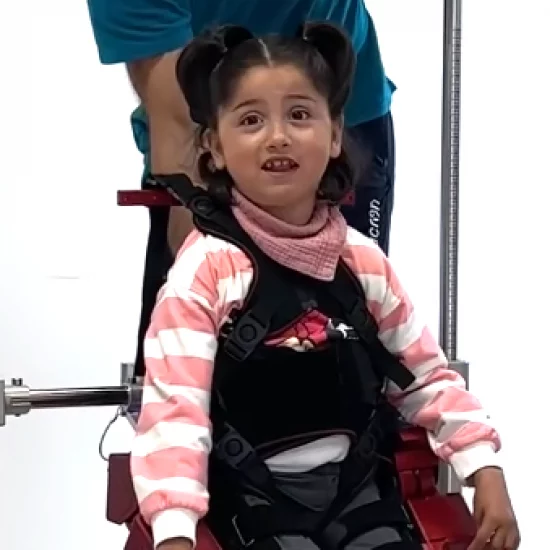
-
"Every time Alejandro is in the exoskeleton, it gives him dignity because human beings are meant to stand upright. When Alejandro is standing, he is happy". Laura, Alejandro's mother
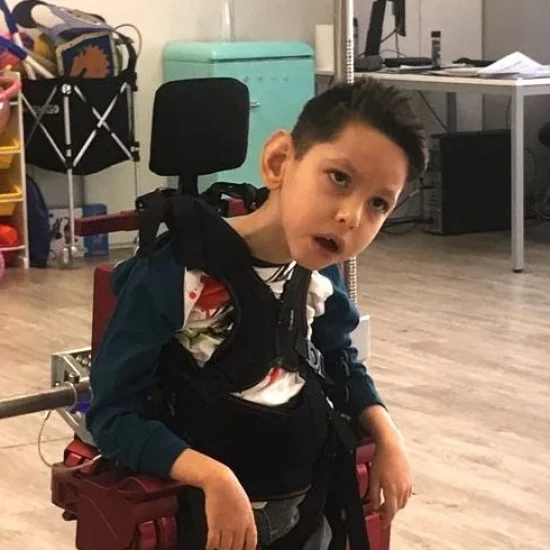
CLINICAL EVIDENCE












